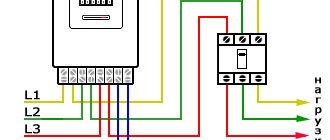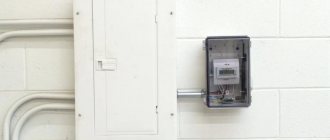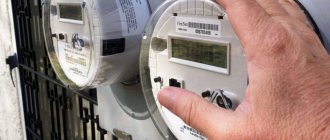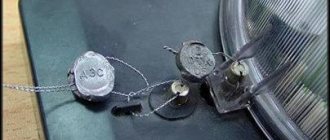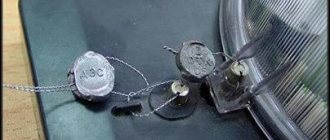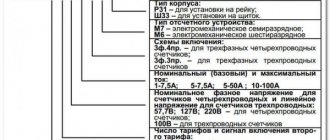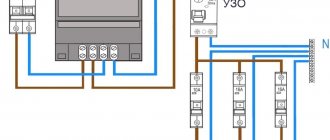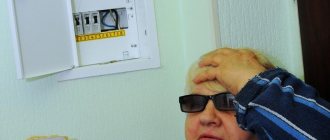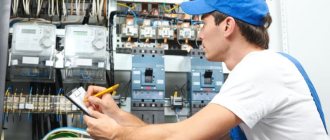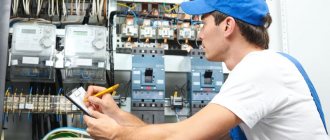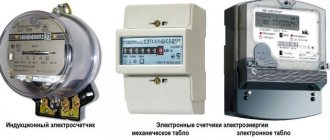The number of electrical appliances used in the home is growing every year. And with it, energy consumption is growing. And if in theory, choosing and installing a meter is the task of the company that sells you electricity, then in practice you make the choice directly. And in order not to overpay, you should decide which meter is better. Nowadays, in houses and apartments in Moscow and the Moscow region, three-phase cable entries are most often used. Such a network makes it possible to turn on more electrical appliances at the same time. Therefore, it is more advisable to buy a three-phase meter. But which one should you choose? This page presents current three-phase electricity meters.
Before buying a meter, decide on the following parameters:
- Network – where you will install the metering device. There are three-phase devices for 380 V power networks and single-phase meters for 220 V.
- Tariffs - the price of a kilowatt of electrical energy is largely determined taking into account the time of day. During peak loads, the cost of the carrier is maximum, and at night it is minimum. If you are satisfied with the appropriate equipment mode, you can save taking this factor into account.
- Accuracy is also an important parameter. If the new meter shows twice as much as the old one, the owners will not like it, and if less, it will raise questions from regulatory authorities.
- Manufacturer – domestic meters are in high demand, the main reason being affordable prices. If you wish, you can choose a high-quality imported device, but the price for it will be higher than for a similar Russian brand.
When purchasing, we also recommend looking at affordability, user reviews and expert opinions.
INCOTEX Mercury 231 AM-01 5(60)
The three-phase meter Mercury 231 from INCOTEX is used to measure and account for electrical energy in three-phase three- or four-wire AC networks for a single-tariff calculation of consumed electricity depending on the time of day. The meter is designed for operation inside confined spaces and in places protected from environmental influences, such as cabinets and panels.
Advantages:
- DIN rail mounting;
- the presence of an IrDA interface that reads meter readings;
- simplicity and versatility of operation even if the circuit connection diagram is broken;
- low price.
Flaws:
- the plastic case is susceptible to direct ultraviolet radiation;
- fragility of the load indication mechanism.
What types of meters are there?
Before answering the question: “which meter is better,” you need to understand what types of meters there are. How do they differ from each other? Electricity meters differ from each other by:
- designs
- number of tariffs
- fastening method
- accuracy class
- the magnitude of the current load.
What is a short circuit? What are the reasons for it and how to prevent it
Design
So, to determine which meter is better, let’s consider the types of these devices. By design, induction and electronic meters are distinguished.
Induction meters are an old design counter; until recently this was the only design option. This is a device with a disk rotating inside, which everyone has long been accustomed to seeing on the staircase or in the apartment. The design of such a device includes two magnetic coils - current and voltage. The magnetic field of the coils sets the disk in motion, which, in turn, is connected to the electricity metering mechanism. These meters are characterized by high reliability and long service life. In accordance with technical documentation, such devices can last at least fifteen years, but in practice, they can often last up to thirty or even fifty years. Unfortunately, the measurement accuracy of such devices leaves much to be desired - the measurement error is quite high.
The electronic meter appeared relatively recently. Meters of this design measure electricity consumption directly. Unlike induction meters, electronic meters do not have any rotating measuring parts, and electricity consumption readings are displayed on an electronic display. In addition, consumption data can be stored in the memory of these devices and, if necessary, transmitted. As for reliability, according to the passport data, devices, like induction ones, should work for at least 10 - 15 years. In practice, it is not yet clear how true this is, since this type of counter appeared relatively recently. The measurement accuracy of such meters is much higher; in addition, they are able to calculate electricity consumption at several tariffs.
Electrical network type
According to the type of electrical network, there are single-phase and three-phase
A single-phase meter is the most common meter, designed for a voltage of 220 volts, like all household electrical appliances. The vast majority of apartments have just such devices, since apartment buildings have a single-phase electrical network.
Three-phase meter - designed for a voltage of 380 volts (three-phase network). As a rule, it is important to use meters of this type in private homes, where it is more likely to use powerful equipment that requires a 380-volt power supply. Examples of such equipment include boilers, water heaters, garden and garage equipment. At the same time, electricity consumption through the 220 volt network, to which all other household electricity consumers are connected, is monitored by a single-phase meter. That is, when using two electrical networks in a private house - single-phase and three-phase, two meters are used.
Number of tariffs
In addition, the meters differ in the number of tariffs. There are single-tariff and multi-tariff meters.
All induction meters are single tariff. Now that they have been replaced by electronic meters, it is possible to calculate energy at two, three or more tariffs. What is it for? The device can separately count the electricity consumed at different times, for example from 6.00 to 22.00 and from 22.00 to 6.00. There are fewer electricity consumers at night, so night rates are cheaper, which encourages more even use of electricity. For example, it may be advantageous to do laundry at night, since washing machines tend to have high energy consumption rates. At the same time, it is impossible to say unequivocally that a multi-tariff meter is better than a single-tariff meter, since it allows you to save electricity, since meters with this function are always much more expensive, despite the fact that the energy savings may not be so significant. It is definitely worth choosing a multi-tariff meter if your apartment uses electric heating or water heating, which already work all night - it is better to pay for such electricity costs at a cheap night tariff.
We add sockets in the apartment ourselves. 5 rules for quick installation
Accuracy class
Electricity meters also differ from each other in their accuracy class. Today, electric meters, in accordance with standards, must have an accuracy class of no higher than 2.0. These numbers reflect the measurement error - the higher the number, the higher the error. Old induction meters had an accuracy class of 2.5. In practice, this means that a device with a higher rating is less able to capture energy consumption from weak loads (for example, from devices running in the background). In essence, it is most beneficial for the consumer to use the device with the highest rating. That is, the optimal choice would be 2.0 - this is the minimum acceptable, but maximum beneficial class for the consumer.
Mounting method
There are two ways to mount the meter: bolt-on and din-rail mounted . The second method is more often used when installed in boxes and panels in buildings and premises. In apartment buildings, the meter is installed on the staircase or in the apartment itself. The placement method may vary. When installing a meter, circuit breaker and RCD together, it is better to choose a meter with DIN rail mounting. Models with this mounting method are much easier to install and dismantle, and since most meters are installed indoors, sometimes in a heated panel, this method looks like the best option. Which meter is better is up to you to decide.
Bolt-on mountings are typically used in outdoor panels. For example, in distribution panels in private houses. This method of fastening is more reliable and prevents shifts and loss of contact.
Basics of power supply for dummies
Current load
Which meter is better to choose based on current load? There are some tips on this matter:
- Firstly, there is no point in installing a meter designed for a current greater than the capacity of the cable supplying voltage to the meter. The easiest way to find out the cable characteristics is at the local housing office from an electrician.
- Secondly, you should consider the maximum load the wiring in your apartment can withstand. To do this, it is advisable to know the cross-section of the cable laid in your home and the material from which it is made. To do this, again, it is best to contact the electrician who laid the wiring in the apartment, if, of course, there is such a possibility.
- Next, you should calculate the total power of household appliances that you are going to use in your apartment (it is better to calculate with a small margin - in case you decide to buy something else). If the total power of all devices is less than 10 kW, a meter designed for a maximum current of 60 Amperes is quite suitable for you. If the output is much more than 10 kW, it is better to choose a device with a maximum current of 80 or even 100 Amperes.
After we have looked at what kind of meters there are in general and which meter is best to choose for certain purposes, it’s time to look at a few specific examples on the market.
Energy meter CE 301 R33 146-JAZ 5(100) A
If you want to buy a meter that is immune to mechanical and weather influences, as well as the influence of the electromagnetic field, you should focus your attention on a 3-phase multi-tariff device from Energomer. It takes into account and displays at 4 tariffs both the total volume of energy consumed and its separate amount for the last 13 months and at the end of each month. In addition, the meter calculates, saves and displays data such as a graph of active powers, the last 20 time adjustments, and network frequency.
The interval between verifications of the Energomer CE 301 meter is more than 10 years. The manufacturer claims 220,000 hours of trouble-free operation. The warranty period for servicing the device after purchase is 4 years. The meter can be operated at temperatures from -40 to +60 °C. If the power limit is exceeded, the device sounds an audible signal.
Advantages:
- IR port IrDA 1.0 or optical interface;
- Protection degree IP50;
- economical energy consumption.
Flaws:
- Loss of time data when power is turned off.
Electricity meter test data
Today, absolutely all electricity meters included in the state register comply with current standards in terms of their metrological characteristics. However, sometimes, to select products, a certain country conducts an independent examination of individual samples in its laboratories.
Thus, according to the magazine “News of Electrical Engineering” No. 1(31) and 2(32) for 2005, at the end of 2004 several types of electricity meters from Russia, Belarus, Ukraine and Lithuania were tested in Belarus. Russian metering devices were presented by three companies. The first ones are already familiar to us:
- Energomera (Stavropol)
- JSC MZEP-1 (Moscow)
and
- Nizhny Novgorod plant named after M.V. Frunze (Nizhny Novgorod)
Without going into the intricacies of the examination, we immediately note that the metrological characteristics of all presented electricity meters were found to comply with GOST.
The fact that Belarusians chose two of the three companies we were considering - manufacturers of electricity meters - for examination speaks volumes. To be fair, we note that Incotex began producing electric meters only in 2001. Before this, its main products were cash registers.
Of course, this is not 2004, and yet...
INCOTEX Mercury 230 AM-02 10(100) A
The three-phase single-tariff electricity meter Mercury 230 AM accounts for unidirectional electricity in 3-phase alternating current circuits directly or through measuring transformers in a digital way. It is equipped with a mechanical display and is designed for operation in dry indoor areas (protection level IP20).
Operating temperature range from -40 to +55. The device is mounted on the surface using screws. In this meter model, the numbers on the display indicate kilowatt hours. The calibration interval, like many meters, is 10 years. The warranty period is 3 years. The average operating time is 140,000 hours.
Advantages:
- simplicity of design and installation;
- equipped with a reverse operation stopper;
- protection against magnetic fields;
- housing made of durable plastic.
Flaws:
- at low voltage in the network, failures in electricity calculations are possible;
- lack of data transfer interface.
Energy meter TsE6803V 1 230V 3ph.4p. M7 P32 10(100) A
A reliable, simple and easy-to-use three-phase single-tariff electricity meter, Energomera TsE6803V, is used both in residential and commercial premises to take readings of consumed electricity. The device has a mechanical reading device. It connects to AC power directly.
On the surface, the counter occupies a space equivalent in size to 5 working modules. According to the manufacturer, the device will last at least 220,000 hours. Like most devices, the calibration interval is 16 years. High degree of protection.
Advantages:
- the presence of a reverse stopper;
- presence of a light indicator of operation;
- high-precision measurements;
- the ability to replace the old meter without having to redo the panel.
- magnetic field protection;
- improved starting current values;
- presence of an anti-reverse mechanism;
- pulse output as an interface.
Flaws
- lack of liquid crystal display;
- big size;
- high price.
Multi-tariff and single-tariff metering devices
If you are going to buy a multi-tariff meter, then it will definitely be an electronic metering device. The selection criteria in this case are the type of load you have in the apartment and the hours of its use. If you are a “night owl” and not a “lark” or you have powerful electric heating devices that are turned on at night, then your choice will be multi-tariff. The higher price of the meter will be repaid many times in the future.
INCOTEX Mercury 230 AM-03 5(7.5) A
The three-phase single-tariff electricity meter INCOTEX Mercury 230 is most often used at commercial facilities. The meter is equipped with a standard telemetric output. In case of any violation in the phasing of the connections of the equipment's current circuits, its operation is carried out in the direction of increasing the electricity consumption readings. The three-phase meter is connected via a transformer. Also equipped with LED indicators of electrical energy consumption and an electromechanical reading device.
The inter-verification interval is slightly less than average and is 10 years. 3 years, this is the warranty period provided by the manufacturer. The specification states that the average time the device will work before it breaks is 140,000 hours.
Advantages:
- magnetic field protection;
- operation in a single tariff mode for metering electrical unidirectional electricity;
- electromechanical op-amp;
- presence of an anti-reverse mechanism;
- pulse output as an interface.
Flaws:
- lack of liquid crystal display.
Is unbalanced meter load a problem?
We often wonder how the asymmetric load on the wires affects the accuracy of the readings, and also which three-phase meter to choose for a private home. Let's imagine a situation in which electric heating is connected to one phase, an induction cooker is connected to another, and the third phase is responsible for the remaining small household appliances. In summer we do not heat the room, so one phase is completely unloaded. Does this affect the measurements taken? A very similar problem is the operation of a device with only one or two phases connected.
Fortunately, electronic electricity meters are excellent at dealing with such problems. We don't need to have a symmetrical load or even all phases connected to the device. This is due to the meter design. Each phase is measured completely separately, and the zero measurement is simply added to the non-zero value and displayed on the LCD screen.
Energy meter TsE6803V 1 230V 3ph.4p. M7 P32 5(60) A
The three-phase single-tariff electricity meter Energomera TsE6803V is used both in the public sector (mobile structures, public and residential buildings, garages, cottages) and in industrial and commercial enterprises. It can be connected to AC power directly or through transformers.
The device is designed to operate at a rated current of 5 A, with a maximum current of 60 A. The manufacturer claims an increased service life of an impressive 30 years, but the warranty is only for 7 years from the date of creation of the meter.
Advantages:
- economical energy consumption;
- low price;
- ease of repair and replacement of meters;
- resistance to weather influences and mechanical damage;
- light indication during operation;
- presence of telemetric pulse output.
Flaws:
- mechanical scoreboard.
Operating principle of instrument transformers
Therefore, the meter will not work and give readings. All devices have electronic seals and have a long service life of up to 16 years.
Today, in continuation, connection diagrams for a single-phase meter, connection diagrams for a three-phase electric meter. Electronic devices Modern electronic electricity metering is organized according to a slightly different principle and allows you to obtain a number of advantages, the main of which are: High accuracy of readings, significantly exceeding the same indicator for an induction device; Possibility of operation in multi-tariff mode; Permissibility of organizing automatic readings. Advantages of installing and operating the Mercury product Mercury current transformer Electric meters of this class are metering devices with which it is possible to measure the energy consumed in three-phase circuits.
The cable connected to outputs L1 and L2 is designed for the required load. The primary circuit is made of a powerful conductive busbar, which is threaded through the center of the device and connected to the gap in the power supply conductors of electrical energy consumers.
Here the work must strictly be carried out by professionals with the appropriate work permits. The correct choice of transformer is of great importance
It is very important to maintain the correct phasing of the windings.
See also: PUE cable in the ground
We connect a three-phase electric meter
Connection diagrams Semi-indirect connection diagram The connection diagram for the meter through current transformers Mercury provides several ways to turn it on, differing in the switching of linear conductors: semi-indirect connection; direct connection; indirect method. Wires with cross-section 1 are connected in the same way.
To avoid confusion if any faults occur, be sure to mark your circuit breakers and meter with the apartment number. The meter also provides a special type of protection that eliminates the possibility of unauthorized entry during attempts to steal electricity. Despite the fact that such devices and their programming are more expensive than single-zone ones, it is beneficial. One of them is connection through ten separate conductive wires.
This simplifies the installation and repair of electrical equipment and significantly reduces the risks during its operation under normal conditions. Therefore, if a person does not have confidence in his own electrician talents when connecting a three-phase electric meter through a transformer, then it is advisable to think about calling a specialist. In addition, this switching method increases the reliability of its operation and operational safety. Installation of a three-phase meter is also carried out in a cabinet.
By analogy, the remaining windings of the transformers are connected to the corresponding contacts on the meter. If clamp assemblies are not available, test blocks must be installed. Connecting heating elements to a three-phase network. Part 2
INCOTEX Mercury 231 AT-01 I (2 tariffs) 5(60) A
Multi-tariff three-phase multi-tariff energy meter INCOTEX Mercury 231 AT-01 is used mainly in residential premises to keep track of electricity consumption in 4-wire 3-phase electric current networks under voltage up to 380 V.
Connects directly to electrical networks and has a verification period of 10 years. The device displays information on a liquid crystal screen. Transmits data on electricity consumption per day, month, in total and for each of the previous 11 months, as well as for the current and previous year, via the IrDA interface.
Advantages:
- high accuracy class;
- ease;
- versatility: works both in the AIMS system and autonomously;
- availability of an event log with the exact date of opening of the device;
- automatic self-diagnosis;
- DIN rail mounting.
Flaws:
- high price;
- fragility of the screw terminals of the terminal block when re-tightening.
What it is
An electricity meter is a common device for monitoring a user's electricity consumption. The reliability of the accounting system directly depends on the correct choice of such equipment. To do this, you need to select the appropriate type of device design for the appropriate electrical network. Thus, you can purchase an electricity meter for single-phase and three-phase wiring.
Typeit NEVA 303 1S0 230V 5(60) A 5(60) A
The single-tariff, three-phase electricity meter Typeit NEVA 303 1S0 230V is used to account and measure the consumption of electrical energy at one tariff in a 3- and 4-wire AC network. The meter base has a spring-loaded clamp and a steel spring in it allows the latch to operate continuously even in adverse weather conditions (such as low temperature).
The meter specification indicates 280,000 hours of operation before failure. The warranty is provided for a full 7 years.
Advantages:
- 1 accuracy class;
- indicator of operation of the measuring device in each phase;
- reliable standard mounting on TN35 rail;
- ease;
- the presence of an electromechanical counting mechanism (EMOU);
- electrical test output of active electricity.
Flaws:
- high cost;
- fragile body.
Accuracy class
According to the rules for electrical installations, today only meters with an accuracy class of 2.0 or less can be connected. If the seller offers you a 2.5 class meter, refuse immediately. This class affects the error in electricity metering. Meters with class 2.5 do not take into account the energy consumption of electronic equipment in standby mode (for example, a TV that is plugged into the outlet but “not showing”). Therefore, energy supply companies immediately demand that such metering be replaced.
INCOTEX Mercury 230 ART-02 CN 10(100) A
The three-phase multi-tariff electricity meter INCOTEX Mercury 230 ART is equipped with a tarifficator that calculates the consumption of active electricity in 16 time zones at 4 different tariffs for each of the 4 types of days. The meter is capable of recording morning and evening limits of reactive and active power.
Advantages:
- presence of a liquid crystal indicator;
- protection against electricity theft due to electronic seal;
- the ability to connect a backup power source;
- self-diagnosis with errors displayed on the display;
- the use of external switching circuits to control the load.
- reliable fastening to the TN-35 rail;
- versatility (used both in residential premises and in enterprises).
Flaws:
- small screen;
- fragile body.
By tariff
But if the choice based on technical characteristics is quite simple for the average user, then some features of modern electricity metering devices can puzzle even an experienced electrician, so it is necessary to familiarize yourself with the typical set of functions of a particular metering device.
there is accounting
- single tariff
— two-tariff
- multi-tariff
The main feature of multi-tariff metering is the difference in the cost of electricity at different times of the day.
The multi-tariff system is beneficial to those who, for example, have electric heating. Thus, it is possible to program the boiler controller so that the peak heating of the premises occurs at night, and during the day the boiler operates at minimum power. For those whose consumption is even throughout the day, a multi-tariff system is often unprofitable. After all, as a result, the amount to be paid remains approximately the same as at a single tariff.
there are following solutions
